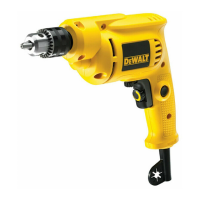9
ENGLISH
Protecting the Environment
w
Separate collection. Products marked with this symbol
must not be disposed of with normal householdwaste.
Products contain materials that can be recovered
or recycled reducing the demand for raw materials.
Please recycle electrical products according to local provisions.
Further information is available at www.2helpU.com.
Optional Accessories
WARNING: Since accessories, other than those offered
by
DeWALT, have not been tested with this product, use
of such accessories with this tool could be hazardous.
To reduce the risk of injury, only
DeWALT recommended
accessories should be used with thisproduct.
Consult your dealer for further information on the
appropriateaccessories.
D
Cleaning
WARNING: Blow dirt and dust out of the main housing
with dry air as often as dirt is seen collecting in and around
the air vents. Wear approved eye protection and approved
dust mask when performing thisprocedure.
WARNING: Never use solvents or other harsh chemicals
for cleaning the non‑metallic parts of the tool. These
chemicals may weaken the materials used in these parts.
Use a cloth dampened only with water and mild soap.
Never let any liquid get inside the tool; never immerse any
part of the tool into aliquid.
C
Lubrication
Your power tool requires no additionallubrication.
Motor Brushes
DeWALT uses an advanced brush system which automatically
stops the drill when the brushes wear out. This prevents
serious damage to the motor. Brushes must be replaced
by an authorised D
eWALT repair agent with identical
replacementparts.
MAINTENANCE
Your power tool has been designed to operate over a long
period of time with a minimum of maintenance. Continuous
satisfactory operation depends upon proper tool care and
regularcleaning.
WARNING: To reduce the risk of serious personal
injury, turn tool off and disconnect tool from power
source before making any adjustments or removing/
installing attachments or accessories. An accidental
start‑up can causeinjury.
CAUTION: Drill may stall if overloaded causing a sudden
twist. Always expect the stall. Grip the drill firmly to control
the twisting action and avoidinjury.
4. IF DRILL STALLS, it is usually because it is being
overloaded or improperly used. RELEASE TRIGGER
IMMEDIATELY, remove drill bit from work, and determine
cause of stalling. DO NOT CLICK TRIGGER ON AND OFF
IN AN ATTEMPT TO START A STALLED DRILL. THIS CAN
DAMAGE THEDRILL.
5. To minimize stalling or breaking through the material,
reduce pressure on drill and ease the bit through the last
fractional part of thehole.
6. Keep the motor running when pulling the bit back out of a
drilled hole. This will help preventjamming.
7. With variable speed drills there is no need to center punch
the point to be drilled. Use a slow speed to start the hole
and accelerate by squeezing the trigger harder when the
hole is deep enough to drill without the bit skippingout.
Drilling in Metal
Start drilling with slow speed and increase to full power while
applying firm pressure on the tool. A smooth even flow of metal
chips indicates the proper drilling rate. Use a cutting lubricant
when drilling metals. The exceptions are cast iron and brass
which should be drilleddry.
NOTE: Large 8mm to 13mm holes in steel can be made easier
if a pilot hole 4mm to 5mm is drilledfirst.
Drilling in Wood
Start drilling with slow speed and increase to full power while
applying firm pressure on the tool. Holes in wood can be
made with the same twist drills used for metal. These bits may
overheat unless pulled out frequently to clear chips from the
flutes. Work that is apt to splinter should be backed up with a
block ofwood.

